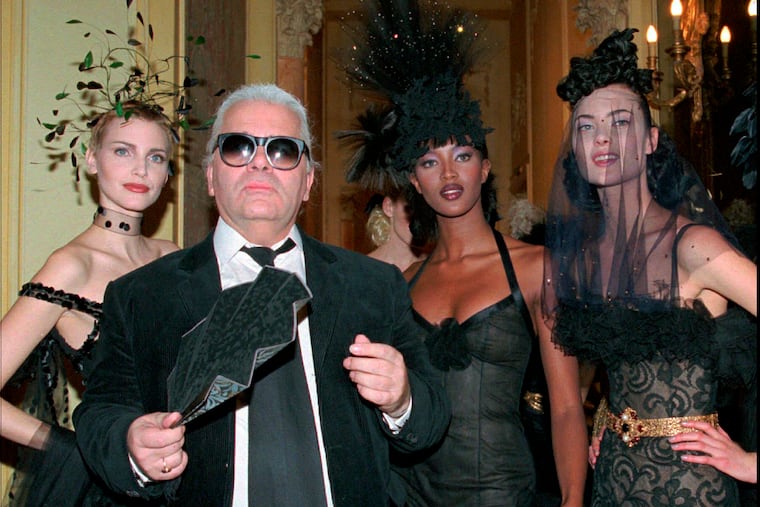He revived Chanel, he made Fendi fun, but we’ll always remember design legend Karl Lagerfeld for that ponytail | Elizabeth Wellington
We won't remember him for a color or a silhouette. We will remember Lagerfeld for being all that is Karl.

We won’t remember Karl Lagerfeld, creative director for the House of Chanel and Fendi, who died Tuesday morning, for creating a signature silhouette.
Nor will we remember the industry’s forever-ponytailed wunderkind for an original take on color or a pump that changed the world.
But we will remember Lagerfeld for being all that is Karl.
Lagerfeld was among the first designers to bask in his own luxe celebrity. He walked the red carpet just like the stars he dressed, and his best friends were the princesses and actresses and models, all of whom, at one time or another, would serve as his muses. In this way he became as recognizable and as much of a household name as they were. That was true genius.
In 1983, after spending two decades turning Fendi into the “Fun Fur” company, he was tasked with bringing the storied French fashion house Chanel back to life. Lagerfeld’s whimsy, eccentricity, and flair for the dramatic made the Chanel tweed a viable fashion commodity again. And he even managed to make the label accessible to everyday dames. Mounting the House of Chanel’s grand fashion shows — which included turning the Grand Palais into a beach in October — became as equally important for fashion culture as what he did for the Chanel plaid.
But what fashion historians will most remember about Lagerfeld’s bombastic career — other than his svelte frame (courtesy of a heavy diet of Diet Cokes), his skinny black suits, his white ponytail, and his Instagram star cat, Choupette — was his ability to do so much at the same time.
Lagerfeld, who reportedly worked up until a few weeks before his death, was his own empire. He led two of the industry’s most prestigious labels. But he also sat at the helm of an eponymous brand, and did not shy away from collaborations, most notably his 2004 partnership with H&M that sold out in a matter of hours. It was one of the first times a high-end designer partnered with a fast fashion brand, now a common practice.
Lagerfeld was smart enough to make his work, no matter what the label said, all about him, helping to cement his celebrity and brand-within-a-brand status. You knew the name Lagerfeld just as much as you knew the name Chanel. He reportedly designed upward of 18 collections a year, and Lagerfeld’s designer-for-hire life became the archetype of how a luxe designer lived — likely inspiring the trajectory of titans John Galliano, the former head of Givenchy and Christian Dior, who is now the creative director for Maison Margiela, and Hedi Slimane, former creative director Dior Mens and Yves Saint Laurent, who now leads Chloé. And then there is Virgil Aboloh, the artistic director of Louis Vuitton and CEO of luxe label Off-White. It’s the kind of impact Kanye West only dreams of having.
Lagerfeld’s age was as much of an enigma as he was. Some put his birth year as 1933, others 1938. In 2013, Lagerfeld told the French magazine Paris Match he was born in 1935, but in 2019 his assistant still didn’t know the truth — telling the Associated Press that Lagerfeld liked “to scramble the tracks on his year of birth — that’s part of the character.” According to the New York Times, the Hamburg Genealogical Society says Karl Otto-Lagerfeld was born in Hamburg, Germany on Sept. 10, 1935. His dad, Otto, was an importer of condensed milk. Friends say his mother, Elizabeth, inspired his style and eccentricity. He wore suits every day to school, likely explaining one of his best known quotes: “Sweatpants are a sign of defeat. You lost control of your life, so you bought some sweatpants.”
He escaped to Paris as a teenager when he was 18. Always a talented artist, he entered a fashion competition then called the International Wool Secretariat (now known as the International Woolmark Prize) in 1954 and won first prize for his sketch of a coat. (It’s worth mentioning that Yves Saint Laurent won in the dress category that year.) Lagerfeld spent the rest of his life rubbing noses with the world’s fashion elite, scoring a job at the House of Balmain before designing for Jean Patou. He did freelance work, where he became a presence with Chloé, and in 1965 he was snatched up by Fendi.
When Chanel came a-calling, Lagerfeld almost didn’t take the job. Chanel was so yesterday, critics told him. Grandma’s plaid at best, detractors warned. But Lagerfeld followed his gut. And we are so glad he did.
This article contains information from the Associated Press.